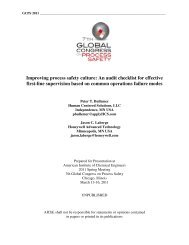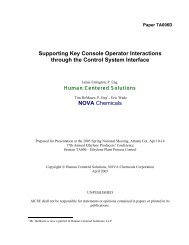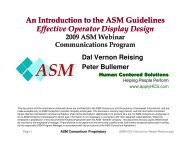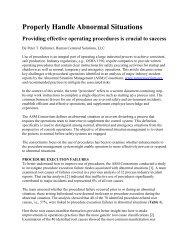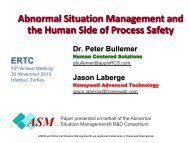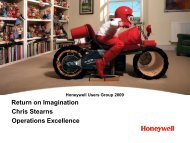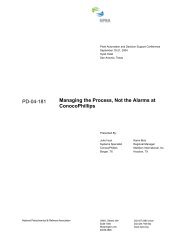Effective Control Center Design for a Better ... - ASM Consortium
Effective Control Center Design for a Better ... - ASM Consortium
Effective Control Center Design for a Better ... - ASM Consortium
Create successful ePaper yourself
Turn your PDF publications into a flip-book with our unique Google optimized e-Paper software.
<strong>Effective</strong> <strong>Control</strong> <strong>Center</strong> <strong>Design</strong> <strong>for</strong> a <strong>Better</strong> Operating<br />
Environment<br />
Edward Cochran<br />
Peter Bullemer<br />
Honeywell Technology <strong>Center</strong><br />
Paul Millner<br />
Chevron, USA<br />
Petrochemical plants are increasingly faced with the need to upgrade their control centers<br />
to support the installation of more advanced control systems and to better protect<br />
operations personnel in the event of catastrophe. Plants often take advantage of this<br />
opportunity to consolidate existing control rooms into a central facility, in hopes of<br />
improving plant-wide communications, increasing operating efficiency, and reducing<br />
construction costs.<br />
However, there are a variety of factors which may negate these advantages, and in fact<br />
initial experiences with centralized control rooms have been decidedly mixed. In fact,<br />
aside from green field plants, fully successful central control room projects are rare.<br />
In retrospect, this should not be surprising. The operations culture of the plant is<br />
profoundly changed by control room consolidation, and the duration and extent of the<br />
resulting disruption can be significant. Some plants have in fact determined through<br />
intensive study that upgrading and maintaining a number of smaller control centers is<br />
more cost-effective in the long run despite higher initial costs.<br />
In this paper, we describe some of the key issues that must be considered in analyzing the<br />
benefits and costs of a central control facility, using operational experiences and case<br />
histories from a variety of plants.<br />
Perceived benefits of Central <strong>Control</strong> Rooms<br />
Central control rooms are often part of a larger strategy to rationalize plant operations<br />
and to upgrade control equipment. As plants evolve and grow over the decades, they<br />
may end up accumulating large numbers of control rooms located adjacent to the units<br />
they control. This puts control room personnel at risk in the event of a serious incident,<br />
and it increases the costs associated with maintaining redundant equipment distributed<br />
around the plant.<br />
Well-designed central control rooms have the obvious benefit of providing better<br />
protection <strong>for</strong> control room personnel. In addition, they are often thought to enhance<br />
communication between units, enabling better coordination of refinery-wide operations<br />
and more effective responses to upsets.<br />
Paper presented at NPRA Computer Conference, November 1999
<strong>Effective</strong> <strong>Control</strong> <strong>Center</strong> <strong>Design</strong> Page 2 of 11<br />
Central control rooms are perceived to provide a cleaner, distraction free work<br />
environment. Locating a central control room away from the center of field operations is<br />
perceived as an opportunity to separate console operators from the day-to-day<br />
interactions with field operations and maintenance. A perceived benefit is a more<br />
focused console operator free of the distractions stemming from the traffic and<br />
congregation of field operators and maintenance staff in the control house.<br />
Central control rooms are also believed to enable both reductions in operations staffing<br />
and a move to more highly trained and knowledgeable console operators.<br />
Observed impacts of central <strong>Control</strong> Rooms<br />
While the perceived benefits of central control rooms are readily apparent, our<br />
experience indicates that they are easily overstated. Worse, there are significant adverse<br />
impacts associated with introducing central control rooms into existing plants, and the<br />
effects of these issues often comes as a surprise.<br />
The majority of the issues associated with central control room projects arise not from<br />
technological or engineering problems but from unanticipated interactions of the new<br />
control room with the plant’s preexisting operations practices. The issues are<br />
organizational, cultural, and psychological. Some of these are different from plant to<br />
plant, but many are common, and we focus on these in this paper.<br />
Disruption of existing refinery operating culture<br />
Operating teams in plants with distributed control rooms often evolve into close-knit<br />
teams with individual cultures. Members of these teams learn to appreciate each other’s<br />
strengths and weaknesses, and they develop predictable responses to problems and<br />
unexpected operating events. While it is not always the case that these responses are<br />
optimal, they are almost always better than the responses of newly <strong>for</strong>med teams. The<br />
introduction of a central control room often results in the dismemberment of existing<br />
operating teams leading to a loss of teamwork and a reduction of understanding of<br />
individual strengths and weaknesses. This can lead to teams which run the plant “by the<br />
book,” which may or may not be a good thing depending on how well developed “the<br />
book” is. It may also lead to team running the plant by the seat of their pants.<br />
Loss of teamwork is further compounded by the fact that console operators in central<br />
control rooms are often running unfamiliar units. Depending on the extent of<br />
consolidation and the presence of union seniority rules, the units may also be staffed by<br />
fewer field operators, and the field operators may also be new to the units.<br />
Paper presented at NPRA Computer Conference, November 1999
<strong>Effective</strong> <strong>Control</strong> <strong>Center</strong> <strong>Design</strong> Page 3 of 11<br />
Reduced communication within units<br />
Central control rooms are designed to increase interaction between the console operators<br />
of different units. But an under-appreciated side effect is that communication within the<br />
unit is reduced, especially between console operators and field operators.<br />
Part of the reason is that voice communication (via radio or phone) is substituted <strong>for</strong><br />
face-to-face communication, and the latter is far more efficient. Also, console operators<br />
are typically running more units, so there is less time available to communicate with all<br />
of them. Finally, since the field operators typically see much more of each other than the<br />
console operator, they set up in<strong>for</strong>mal communication methods in the field—such as<br />
blind lists and out of service logs—which are not accessible to the console operators.<br />
The reduction in communication leads to unexpected difficulty with routine ef<strong>for</strong>ts such<br />
as maintenance coordination, permitting, and Lock Out/Tag Out. We have frequently<br />
observed field operators and console operators in remote control rooms working at crosspurposes.<br />
It is not uncommon to see mistakes by field operators that are not announced<br />
to console operators. These kinds of communication problems have led to serious<br />
incidents, such as the wrong drum being opened on a coker or the wrong line-up being<br />
completed <strong>for</strong> a product stream.<br />
Perception of inequitable working environments<br />
Both console operators and field operators perceive inequities in differentiation of their<br />
job tasks. Console operators decry the burden of responsibility they bear, relative to their<br />
more limited plant scope peers working outside. Dissatisfaction also flow from<br />
converting employees who signed up <strong>for</strong> a “walking around out of doors” job to<br />
“clerical” computer workers: long hours of sitting, visual fatigue, and reduced diversity<br />
in work location. Field operators recognize that they’re now af<strong>for</strong>ded less opportunity to<br />
enjoy the climate controlled cocoon, protected from the weather and the risks of the plant<br />
environment. In addition, they fear that their process knowledge and control expertise<br />
may deteriorate, due to reduced exposure, with possible negative implications <strong>for</strong> career<br />
advancement.<br />
Failure to achieve plant-wide collaboration<br />
Perhaps the most surprising observation we have made, at least to central control room<br />
advocates, is that central control rooms do not appear to succeed in promoting inter-unit<br />
communication in those plants in which inter-unit communication is a problem. We have<br />
seen central control rooms, introduced to address communications problems between<br />
units of a plant, in which the units are run from consoles that, although located in the<br />
same room, are as isolated as ever: Operators still do not work together. Moreover, they<br />
tend to communicate only via telephones rather than face-to-face. Especially in abnormal<br />
situations, the primary means of communication that we have observed is the telephone.<br />
Paper presented at NPRA Computer Conference, November 1999
<strong>Effective</strong> <strong>Control</strong> <strong>Center</strong> <strong>Design</strong> Page 4 of 11<br />
In hindsight, this should not be surprising: Communication issues are much more due to<br />
organizational issues than they are to physical location. Plants with distributed control<br />
rooms and a strong communications culture overcome the obstacles. Plants with a weak<br />
communications culture should not assume that the obstacles are physical—they rarely<br />
are.<br />
Loss of field knowledge by console operators<br />
Central control rooms often result in dedicated console operators. Unless specific actions<br />
are taken, the result is usually that the console operators gradually lose awareness of and<br />
knowledge about conditions in and the nature of the field operator’s environment. We<br />
have observed several consequences of this. First, the console operators may begin to<br />
treat their job as a sort of video game, and lose sight of the fact that the indications on the<br />
screen represent physical processes with physical attributes. In one case we witnessed, a<br />
console operator <strong>for</strong>got that two process drums were located quite far apart, even thought<br />
they were near each other on the schematic. In another case, an operator lost sight of the<br />
fact that the rate at which a tank filled on the schematic was a function of process<br />
hydraulics, not the processor speed of the display computer.<br />
Second, the console operator may have a reduced understanding of the field operator’s<br />
tasks. For example, the time to catch a sample depends on a variety of factors, including<br />
the kind of sample, the sampling equipment, the location of the sampling point, the<br />
location of the sample containers, and so on. Without continued exposure to these<br />
variables, console operators may not realize how much time is needed to do even this<br />
routine job. Over time, this lack of understanding can lead to different mental models of<br />
how operations are carried out, and it can also become a source of friction between the<br />
central control room and the field.<br />
Different distractions affect operator attention<br />
While it is true that the placement of a central control room away from the field<br />
minimizes distractions from the traffic and congregation of field operators and<br />
maintenance staff, other sources of distractions emerge in the “fishbowl” of central<br />
control rooms. When several consoles are located in a large common area, significant<br />
distraction can emerge from the noise and lighting configurations around other consoles.<br />
Each console has an alarm system to alert operators to significant process events. We<br />
have observed configurations where operators are distracted by each other’s alarm<br />
annunciations. In some cases, operators can even be confused as to whose alarm system<br />
is annunciating. The console operator can also be distracted by the consultations going<br />
on over another console.<br />
The central access of console operators to engineers and managers provides more<br />
opportunity <strong>for</strong> face-to-face discussions. So while the console operators may be chatting<br />
Paper presented at NPRA Computer Conference, November 1999
<strong>Effective</strong> <strong>Control</strong> <strong>Center</strong> <strong>Design</strong> Page 5 of 11<br />
less with field operators or maintenance personnel, they are still exposed to face to face<br />
conversations. The major distraction comes when the target of the conversation is with<br />
an adjacent console operator. And finally, operators also have to contend with the music<br />
or lighting preferences of the neighboring console operator. It seems as though each<br />
individual operator has a slightly different preference <strong>for</strong> music loudness or lighting<br />
brightness. Un<strong>for</strong>tunately, console operators are often left to police this issue on their<br />
own and the most aggressive personalities tend to win. Although these same irritants can<br />
exist in field control centers, the interdependent, rotational nature of the field operator<br />
relationships encourage achieving an accommodation (I’ll get my turn...). These<br />
interdependencies are slow to be recognized in newly centralized control facilities.<br />
Shortage of operators wanting to work the console<br />
A number of sites we have visited have been surprised that the central control room job is<br />
perceived to be undesirable, even when a pay differential is present. The central control<br />
room may be perceived as a stressful place to work, in which everyone is always on duty.<br />
It may be perceived as a cave. People may feel that they are under a microscope, and that<br />
every mistake will be identified as a cause <strong>for</strong> discipline. Alienation from historical field<br />
crew relationships, closer working relationships with unfamiliar technical and<br />
management personnel, and the risk of being perceived as an overachiever by their<br />
coworkers dissuades some otherwise exemplary console operator candidates.<br />
Factors to consider when choosing between a central control<br />
room and a distributed control room<br />
We do not mean to imply that central control rooms should not be built, nor that good<br />
success is not possible. We believe that the reason that it has been relatively rare to date<br />
is that central control room projects have not been broad enough; that is, the requirements<br />
of the central control room project have excluded organizational issues. Some of the<br />
issues that we believe must be considered in any central control room decision are listed<br />
below.<br />
Shared understanding of goals<br />
By far the most common error in our experience is that the central control room is<br />
authorized in the absence of a broad understanding of what the alternatives are. The<br />
experiences cited above indicate that a central control room is not a quick fix <strong>for</strong> cultural<br />
issues, communication problems, or reliability concerns. Plants with cultural or<br />
communications issues need to understand the source of those and deal directly with that<br />
source—it is rarely a problem with distance. Plants that have problems controlling<br />
refinery-wide upsets may benefit much more from a concerted ef<strong>for</strong>t to address how<br />
upsets get started in the first place. Plants with reliability issues might benefit from<br />
increased staffing levels or an enhanced preventive maintenance program much more<br />
than from a central control room.<br />
Paper presented at NPRA Computer Conference, November 1999
<strong>Effective</strong> <strong>Control</strong> <strong>Center</strong> <strong>Design</strong> Page 6 of 11<br />
Full accounting of costs and benefits<br />
It is important to make careful allocations of benefits among the various features of a<br />
central control room project Anticipated savings need to be analyzed and appropriately<br />
distributed to the central control room itself, versus the effects of any staffing<br />
consolidation, enhanced procedures, control system upgrades, process upgrades,<br />
organizational development, better training, and so on. These solutions are potentially<br />
independent, and their cost benefit ratios may vary widely.<br />
Plants also need to fully anticipate and plan <strong>for</strong> the downside of a central control room.<br />
Change causes problems, and big changes cause big problems. The change may<br />
nevertheless be justified, but central control room planners need to resist optimism in<br />
predicting when benefits will start accruing. In our experience, there are several factors<br />
that are often missed in assessing the impact of a central control room.<br />
Existing operations culture. Established operations cultures often provide value that is<br />
under-appreciated. It is not uncommon <strong>for</strong> different units in a plant to have separate<br />
reputations, and even to have different ways of doing things. These differences tend to<br />
become amplified over time, leading to nicknames., logos, mascots, and internal<br />
competition. The costs of this kind of divergence are almost always more visible than the<br />
benefits.<br />
One reason is that the costs are misrepresented. For example, consider a situation in<br />
which internal competition that leads one unit to develop better ways of doing something<br />
that are not shared with other units. Many plants would consider the competition to be a<br />
problem, and cite the lack of sharing as a cost. We would rather conclude that, although<br />
the competition has undesirable elements, it has in fact produced the benefits that the<br />
organization wants to share.<br />
Size of Operation/subdivision of units. <strong>Effective</strong> operating teams tend to be composed<br />
of five to ten people. Larger teams tend to <strong>for</strong>m subcultures, and smaller teams are less<br />
able to include the knowledge and other resources that are needed.<br />
In developing plans <strong>for</strong> central control rooms, it is often the case that a project team<br />
assigns console operators to process units based solely on the characteristics of the<br />
process units—their complexity, the number of control loops, and so on. However, a<br />
console operator is not just an operator of the process, but a coordinator of an operations<br />
team. If that team is too big or too small, the console operator’s workload will increase,<br />
and the assumption used to allocate units may become invalid.<br />
Physical layout of plant. The issues associated with locating a central control room in a<br />
relatively small, compact plant are very different than those associated with a large plant,<br />
particularly if there are barriers to movement to contend with such as terrain, railroads,<br />
waterfronts, or highways. Long distances (greater than about three minutes transit time)<br />
between central control room and units causes problems <strong>for</strong> which we do not yet have<br />
case studies of success. In these cases, a central control room must also be a remote<br />
Paper presented at NPRA Computer Conference, November 1999
<strong>Effective</strong> <strong>Control</strong> <strong>Center</strong> <strong>Design</strong> Page 7 of 11<br />
control room, and it is not clear that in<strong>for</strong>mation technology has yet advanced far enough<br />
to ensure success <strong>for</strong> large process plants.<br />
Ensuring the success of a central control room project<br />
Assuming a central control room is appropriate, there are implementation issues that must<br />
be considered, but which are often overlooked.<br />
Rotation of personnel among operating positions<br />
In our experience, the dedicated console operator model is difficult to do well (unless<br />
units are highly automated and field positions are deliberately de-skilled). Good success<br />
stories in case studies are rare.<br />
Sites that rotate operators among operating positions have had more success. Not only<br />
does this support the maintenance of skills among the operators, but also the transfer of<br />
knowledge as they take turns operating in the same areas and discuss the problems they<br />
encounter. Rotation is especially effective (but more difficult to implement) when<br />
consolidation is a goal, because operators need to learn new units quickly. However,<br />
rotation need not be homogeneous: The console operator duties can rotate among a<br />
subset of a crew, with that subset changing over longer periods of time. Although rotation<br />
is not a substitute <strong>for</strong> training, it is an excellent supplement.<br />
Need to support operations changes with systematic ef<strong>for</strong>t<br />
The change that will ensue from a control room consolidation is difficult to overstate.<br />
Sites that have had success have focused on systematically supporting the change process<br />
with a wide range of ancillary ef<strong>for</strong>ts.<br />
Procedures. The plant’s procedure system usually requires comprehensive review,<br />
especially if consolidation of operating positions is contemplated. It is often the case that<br />
existing operations team have developed in<strong>for</strong>mal supplementary procedures,<br />
workarounds, or short cuts that need to be identified and either integrated into the <strong>for</strong>mal<br />
procedures or consciously abandoned. Procedures that involve the interaction of<br />
different operators must be carefully audited. This is also the time to survey procedures<br />
to identify those that involve multiple units, and to determine if the coordination<br />
mechanisms within those procedures will still be appropriate in a central control room.<br />
Incident and near miss reporting. The change to a new operating paradigm will require<br />
significant learning, and the incident and near miss reporting system is a key tool in that<br />
regard. Deficiencies in the system should be identified and eliminated very early in the<br />
central control room project. If a punitive culture exists, significant ef<strong>for</strong>t may be<br />
required to ensure that operating issues are in fact identified. Change in such cultures is<br />
Paper presented at NPRA Computer Conference, November 1999
<strong>Effective</strong> <strong>Control</strong> <strong>Center</strong> <strong>Design</strong> Page 8 of 11<br />
usually very difficult, and organizational change ef<strong>for</strong>ts may be beneficial prior to<br />
starting a central control room implementation project.<br />
Training. A systematic ef<strong>for</strong>t to identify training needs <strong>for</strong> the new organization should<br />
be an early action. <strong>Design</strong> and implementation of a training program is needed prior to<br />
the transition to the new organization.<br />
The training program needs to include the definition of roles and responsibilities.<br />
Specifically, roles and responsibilities need to be defined in the areas of decision making,<br />
collaborative interactions, and new work practices and tools. In the area of decision<br />
making, operators need to know the scope and context of individual decisions and team<br />
decisions. For example, the final authority on decisions to reduce throughput needs to be<br />
clear. Similarly, one person needs to be designated as responsible <strong>for</strong> coordinating the<br />
activity of other operators in the field during an abnormal situation. When<br />
communicating problems, the console operators need to know whom to interact with,<br />
how their process can impact other areas, and what they need to communicate in<br />
collaborative interactions.<br />
Cultural change. Most importantly, change agents need to be aware that cultural change<br />
does not necessarily come about through traditional training approaches or alterations of<br />
the physical space. Cultural changes require considerable ef<strong>for</strong>t to alter the values and<br />
beliefs engrained in each individual. Changes to values and beliefs require the<br />
implementation of programs that address individual employee motivations such a<br />
per<strong>for</strong>mance recognition, pay incentives, peer approval, pride in contribution to the larger<br />
ef<strong>for</strong>t, or avoidance of harm.<br />
Workload factors. Central control rooms almost always result in increased workload<br />
even when consolidation of operating positions is not part of the program. A variety of<br />
measures, such as more <strong>for</strong>malized shift changes, better logging, alarm system<br />
enhancements, and better communications protocols, can minimize the impact. In<br />
addition, comprehensive upgrades in field ergonomics may be warranted, in order to<br />
increase efficiency in the field, and to ease coordination between console operator and<br />
field operator.<br />
Communications technology. Moving console operators to a central control room<br />
requires more communications technology than better radios. Systematic measures must<br />
be taken to combat the inevitable loss of in<strong>for</strong>mation that occurs when face-to-face<br />
communication is eliminated, and to ensure that in<strong>for</strong>mation is widely shared within the<br />
plant. On-line procedures, remote video, field access to process in<strong>for</strong>mation, and<br />
improved on-line access to a wide variety of plant in<strong>for</strong>mation may be required.<br />
Opportunity to supplement operations changes with changes in other areas<br />
It is often the case that the full benefit of changes in one area are not realized as expected<br />
because of unanticipated bottlenecks that arise in other areas. Although a full analysis of<br />
this problem is outside the scope of this paper, three areas in particular deserve mention.<br />
Paper presented at NPRA Computer Conference, November 1999
<strong>Effective</strong> <strong>Control</strong> <strong>Center</strong> <strong>Design</strong> Page 9 of 11<br />
Maintenance system. As the new operational paradigm takes hold, maintenance issues<br />
may become a new bottleneck to more efficient operations. For example, a plant that has<br />
become operationally capable of more flexible operations (e.g., rapid changes in product<br />
slate) may be unable to take advantage of that capability if the necessary process or<br />
control equipment is out of service a large proportion of the time.<br />
Increased instrumentation/automation The introduction of more efficient operations<br />
may change the relative benefits of instrumentation upgrades. If a plant can eliminate<br />
operations disruptions and spend a larger proportion of time running near capacity,<br />
optimization systems may be warranted even if they hadn’t seemed cost-effective in the<br />
past.<br />
Plant improvements. The potential benefits of a central control room may be easier to<br />
achieve if certain changes to the physical plant are made. For example, ef<strong>for</strong>ts to reduce<br />
inventory <strong>for</strong> economic reasons notwithstanding, the addition of intermediate storage<br />
between units may provide even greater benefits by helping to isolate process upsets.<br />
Alternatively, tighter integration may require providing operators with advanced<br />
automation tools to compensate.<br />
The consolidation of multiple redundant functions (e.g., multiple vapor recovery units)<br />
may not be economically justified, but the addition of additional linkages between such<br />
similar units may enable a plant to respond with more flexibility to unplanned outages or<br />
changes in the economic climate.<br />
Finally, increased sparing of critical equipment may also reduce stress on operators that<br />
is often caused when the plant is run in unusual configurations due to outages. Similarly,<br />
abnormal situation management tools can increase operator com<strong>for</strong>t with such operating<br />
modes.<br />
Metrics<br />
The current enthusiasm <strong>for</strong> the central control room “solution” is in part because the<br />
benefits are immediate using existing measures. For example, since well-known<br />
benchmarking services report console operator staffing levels, a central control room has<br />
a very predictable and immediate impact. Overall operational effectiveness, however, is<br />
less well measured.<br />
A central control room is a very visible change, much flashier than, <strong>for</strong> example,<br />
sustained ef<strong>for</strong>t at improving procedures. Embarking on a central control room project<br />
clearly signals that action is being taken to solve a problem. It is a solution that is easy to<br />
make intuitive arguments <strong>for</strong>, and the benefits arguments can be intuitively persuasive.<br />
Un<strong>for</strong>tunately, intuition is not always correct in large organizations. For example, we<br />
have observed people conclude that workers’ failure to act appropriately in conducting<br />
routine pump preventive maintenance required improvements to the training program.<br />
However, it turned out that the failure had more to do with the failure of the plant to<br />
provide sufficient support <strong>for</strong> the practice than it did with workers’ not knowing what to<br />
Paper presented at NPRA Computer Conference, November 1999
<strong>Effective</strong> <strong>Control</strong> <strong>Center</strong> <strong>Design</strong> Page 10 of 11<br />
do. The workers did not have time to conduct the procedures given the design of the work<br />
environment, availability of tools, resources to execute the existing procedures and the<br />
priority given to preventive maintenance tasks. Plants need to focus on understanding the<br />
essence of problems and potential <strong>for</strong> real benefits.<br />
In many cases, plants may need to create a metrics system in order to carry out a<br />
principled cost/benefit analysis be<strong>for</strong>e embarking on a central control room project.<br />
When this is true, it is also evidence of why change in that plant is difficult: If measures<br />
are lacking, it is nearly impossible <strong>for</strong> a large organization to be aligned enough to<br />
successfully carry out a systematic improvement program.<br />
Conclusions<br />
Process plants such as oil refineries are among the most complex systems on the planet,<br />
rivaling weapons systems, airliners, and manned spacecraft. Unlike those systems,<br />
however, process plants are sometimes not as well controlled. A primary reason <strong>for</strong> this<br />
is because they are operated by large organizations of people.<br />
In airliners, pilots have the span of control and the tools to permit one individual to be<br />
truly “in control.” In military systems, commanders have military discipline and the<br />
chain of command to permit one person to be truly “in control,” or at least “in charge.”<br />
In space operations, budgets permit extensive planning, significant redundancy, a large<br />
organization, and clear lines of authority, so again, the system as a whole is usually very<br />
well controlled.<br />
Nevertheless, significant operational problems and occasional disasters occur in all of<br />
these systems. Airliners crash; aircraft carriers collide with their escorts; satellites are lost<br />
due to operational errors; spacecraft collide with space stations. By far the largest source<br />
of these incidents is this: People are not perfect. They are not perfect in carrying out<br />
routine operations; they are not perfect in responding to unexpected events; they are not<br />
perfect in handling major crises.<br />
Organizations devote considerable ef<strong>for</strong>t to making sure that their systems are engineered<br />
insofar as practical to avoid the simple consequences of that fact. In process plants, there<br />
are multiple engineering solutions to the problem, including protective devices, shutdown<br />
systems, procedures, training, and organizational initiatives. There are also in<strong>for</strong>mal<br />
solutions, such as the operational experience and unit cultures that evolve of years of<br />
plant operation. By and large, these approaches are very successful, in that plants<br />
continue to improve.<br />
The jury is still out on how a central control room can become yet another tool <strong>for</strong><br />
improving operations. Intuitively, the advantages are obvious. However, the early<br />
experiences of the industry appear to us to indicate that this tool needs to be used with<br />
caution: The introduction of a central control room by definition disrupts many of the<br />
organizational systems that are in place to efficiently operate process plants. The<br />
Paper presented at NPRA Computer Conference, November 1999
<strong>Effective</strong> <strong>Control</strong> <strong>Center</strong> <strong>Design</strong> Page 11 of 11<br />
significance of the disruption has been surprising, but plants are now in a position to<br />
anticipate most of the negative effects and plan to minimize their impact.<br />
Paper presented at NPRA Computer Conference, November 1999



